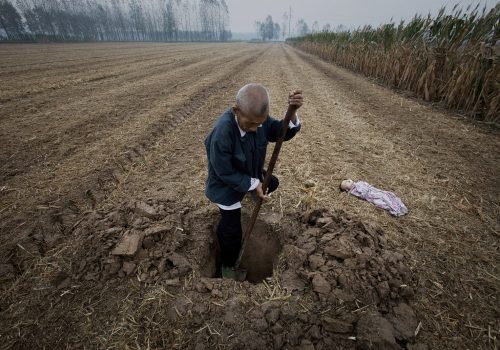Do we realize the harmfulness of human greed in seeking to exploit ever more the resources of Earth just for short term material prosperity?
But do we know the disastrous consequences hidden behind this prosperity that Lu Guang euphemistically calls “development”? We can always refer the history mirror back to the so-called developed countries, and that is the language of revenge often borrowed by China: “you had abused the Earth enough for a long time, now it is our turn and you have no right to lecture us.”
But no country has gone as far in the devastation of the eco-system, no other economy has been as unscrupulous predatory. If the Western society has seen the birth of green movements and a generalization of an ecological culture, all that remains at an embryonic stage in China. It is true however, that not so many countries have had one billion and five hundred million mouths to feed, as many bodies to dress, to heat, and to transport, all this in a record time, in three decades! And in thirty years the warfare by industrial developers against Mother Nature has been terrifying, and will leave long-term aftermath. That makes Lu Guang’s photographic vision drawn from his 15-year battle even more remarkable, not so much for being spectacular but because of the absence of the spectacular, since it is simply hyper-realistic.
Lu Guang came to Shanghai one day in 2009 to warn me about the water I was drinking, he showed me a map of the Yangtze where he had placed hundreds of colorful dots along its shoreline, telling me those were all sorts of large industries, including Fortune 500’s multinational corporations, there were steel mills, paper mills, power plants, chemical industrial parks, textile factories, tint and dye plants, all of them had been dumping their waste waters, untreated, directly, into the Mother of Chinese rivers! “Since the Yangtze feeds into the Taihu lake which is the reservoir for Shanghai’s drinking water, you see, your health is compromised, my friend!” Then he ran a screening of his terrifying pictures on his laptop. That was before he received the W. Eugene Smith Grant for Humanistic Photography.
One of the best examples of Lu Guang’s man-altered landscapes is this world famous Hulun Buir Grassland in Inner Mongolia, where a decade of relentless open-pitch mining has left it pockmarked with huge gaping sinkholes. And all these close-up portraits of victims: faces of cancer-stricken farmers and fishermen, lead-poisoned children, abandoned orphans because of their deformation or their disability, these are the results of water pollution, air pollution, and soil contamination. Of course poverty plays a role too, for there are the left-asides of the economic great leap forward. We are unmercifully led from those sinkholes of Inner Mongolia to the tiny hole that this farmer was obliged to dig in order to burry an infant in his field. As Lu Guang told me: “I was investigating a story of orphans in the city of Lankao in Henan Province, when I caught sight of this peasant carrying the lifeless body of a baby. I realized he was going to throw it into a garbage dump. So I stopped him and begged him to give the baby a decent burial. The old man said the mother was a young girl of the village who went to work in the city and came home pregnant. But she gave birth to a sick child with disability, and she had no money to take care of him so she simply abandoned the baby.”
Jean Loh
Jean Loh is a writer specializing in photography. He lives and works in Shanghai, China.
Lu Guang, Développement et Pollution
Visa pour l’Image Festival
Couvent des Minimes
12 Rue Louis Bausil
66000 Perpignan
France
http://www.visapourlimage.com/
















